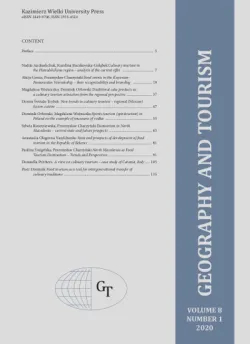Illegal wildlife products as tourist souvenirs – an outline of the problem from the perspective of Poland
DOI:
https://doi.org/10.34767/GAT.2021.09.04Keywords:
sustainable development, tourism, travel, souvenirs, animals, poachingAbstract
The article aims to outline the problem of transporting illegal plant and animal souvenirs by tourists and to analyse the issue from the perspective of Poland. Tourists’ interest in buying wildlife souvenirs is varied, ranging from live animals and plants to food products, leather and wooden goods, and medicines. Travellers buying illegal souvenirs of plant and animal origin often unwittingly contribute to the extinction of the most endangered plant and animal species. The number of CITES specimens seized in Poland annually is approximately 134 between 2009 and 2018 on average. In 2018 alone, nearly 14 thousand specimens were confiscated. These confiscations were largely directed towards Ukraine. However, despite the fact that the problem is acknowledged in the country, and legal regulations have been introduced to counteract it, the tourism sector seems to be oblivious to the problem, and the subject does not appear in the scope of activities pursued by organizations related to the development and promotion of tourism. So far it has rarely been mentioned in the scientific literature, including the field of tourism. The authors hope that the presented analyses will draw attention to the problem and lead to the implementation of more sustainable practices In Polish tourism.
References
Banaszkiewicz M., 2011. Tourist souvenirs – in search of identity. Turystyka Kulturowa 4, 4-16 [In Polish with English abstract].
Buczkowska K., 2012. Jakość podróży zatrzymana w pamiątkach. [In:] Kazimierczak M. (Ed.), Jakość życia w kulturowych przestrzeniach podróżowania. Akademia Wychowania Fizycznego w Poznaniu, Poznań, 78–95 [In Polish].
Chackiewicz M., 2008. Ekologiczne i społeczne aspekty przemytu ginących gatunków roślin i zwierząt. Monitor Prawa Celnego i Podatkowego 12, 444 [In Polish].
Chackiewicz M., 2012. CITES a międzynarodowy obrót towarowy. Wyższa Szkoła Cła i Logistyki, Warszawa, pp. 177 [In Polish].
Chackiewicz M., 2015. Świat i jego problemy związane z przemytem i nielegalnym handlem ginącymi gatunkami flory i fauny. [In:] Skorowski H. (Ed.), Świat i jego problemy. Międzynarodowe Centrum Dialogu Międzykulturowego i Międzyreligijnego UKSW, Warszawa, 369–380 [In Polish].
Chackiewicz M., 2016. Smuggling of endangered species of fauna through the check points between Poland and Ukraine. Almanach Mieżdunarodnogo Prawa 11, 32-42 [In Polish with English abstract].
Chackiewicz M., Kostecka J., 2017. Seizure of biodiversity resources under Washington Convention (CITES) by the Polish Customs Service. Inżynieria Ekologiczna 18(3), 129-138 [In Polish with English abstract].
Christy B., 2019. Handel dzikim życiem „Nic mi nie mogą zrobić. Mogę sprzedać pandę i nic mi się nie stanie”, https://www.national-geographic.pl/artykul/handel-dzikim-zyciem [In Polish].
Felbab-Brown V.F., 2017. The Extinction Market Wildlife Trafficking and How to Counter It. Oxford University Press, New York, NY, pp. 406.
Gómez A., Aguirre A. , 2008. Infectious Diseases and the Illegal Wildlife Trade. Annals Of The New York Academy Of Sciences 1149(1), 16-19.
Haenlein C., Keatinge T., 2017. Follow the Money: Using Financial Investigation to Combat Wildlife Crime. RUSI Occasional Paper. Royal United Service Institute for Defence and Security Studies, Stephen Austin and Sons, Ltd., London, pp. 33.
Harfoot M., Glaser S.A.M., Tittensor D.P., Britten G.L., McLardy C., Malsch K., Burgess N.D., 2018. Unveiling the patterns and trends in 40 years of global trade in CITES-listed wildlife. Biological Conservation 223, 47–57.
Harrison M., Baker J., Twinamatsiko M., Milner-Gulland E.J., 2015. Profiling unauthorized natural resource users for better targeting of conservation interventions. Conservation Biology 29(6), 1636-1646.
Kideghesho J., 2016. Reversing the trend of wildlife crime in Tanzania: challenges and opportunities. Biodiversity and Conservation 25(3), 427-449.
Klimczyk B., Zwolińska M., 2017. Unique and ordinary souvenirs from Łódź as a way to preserve memories from the journey. Warsztaty z Geografii Turyzmu 1(8), 55-62 [In Polish with English abstract].
Listos P., Dylewska M., Gryzińska M., 2016. Inconsistent with the Washington Convention (CITES) smuggling animals to Poland. ŻycieWeterynaryjne 91(4), 238-243 [In Polish with English abstract].
Pabian A., Pabian A., Brzeziński A., 2020. Young People Collecting Natural Souvenirs: A Perspective of Sustainability and Marketing Sustainability 12, 514.
Podemski K., 2004. Sociology of Travel. Wydawnictwo Naukowe im. Adama Mickiewicza w Poznaniu, pp. 93 [In Polish with English summary].
Rosen G., Smith K., 2010. Summarizing the Evidence on the International Trade in Illegal Wildlife. Ecohealth 7(1), 24-32.
Sosenko K., 2009. Kobieta w podróży. [In:] Krasny P., Ziarkowski D. (Eds.), Sztuka i podróżowanie. Studia teoretyczne i historyczno-artystyczne. Wydawnictwo Proksenia, Kraków, 263–264 [In Polish].
Tusiński R., 2009. Konwencja Waszyngtońska czyli CITES. Wiadomości Celne 10-11. Ministerstwo Finansów – Służba Celna, Warszawa, 3-24 [In Polish].
Underwood F.M., Burn R.W., Milliken T., 2013. Dissecting the Illegal Ivory Trade: An Analysis of Ivory Seizures Data. PLoS ONE 8(10), e76539. ISSN 1932-6203.
Wittemyer G., Northrup J.M., Blanc J., Douglas-Hamilton I., Omondi P., Burnham K.P., 2014. Illegal killing for ivory drives global decline in African elephants. Proceedings of the National Academy of Sciences 111(36), 13117-13121.
Wojciechowska J., Kupis W., 2014. Souvenirs Inspired by Folk Culture in the Region of Łowicz. Folia Turistica 31, 105–125 [In Polish with English abstract].van Uhm D.P., 2016. The illegal wildlife trade: Inside the world of poachers, smugglers and traders. Springer International Publishing, Switzerland, pp. 328.
Veríssimo D., Challende, D., Nijman V., 2012. Wildlife trade in Asia: Start with the consumer. Asian Journal of Conservation Biology 1(2), 49-50.

